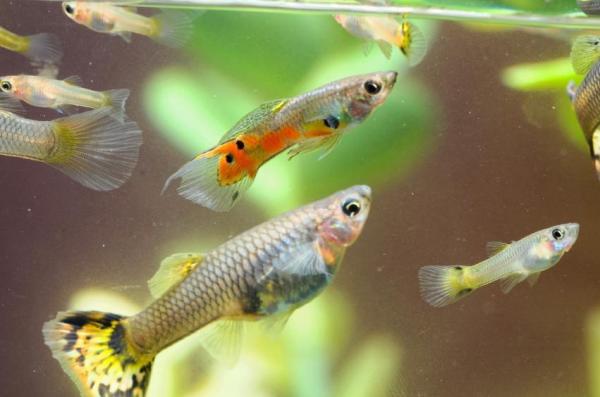
If you have a fishbowl or aquarium, you should know that fish can give birth in two different ways. The first is to hide its eggs in plants or soil so that after a male spreads his semen above them, these eggs can hatch. Another type of fish may become pregnant and give birth just like a cat or a dog. Therefore, to know if your fish is pregnant, you must first find out if the female lays eggs or gives birth, then distinguish between males and females and finally look for certain anatomical changes in the female fish.
Viviparous species
The only species of fish that gets pregnant is the viviparous kind. Others such as the Betta fish don't even mate in the conventional way. If you are uncertain if your fish is viviparous and gives birth or is oviparous and lays eggs, take a look at our list of viviparous fish.
Guppies, swordtails, and platy and molly fish are common viviparous fish. In this case, the first female eggs are inside it, and then it mates with males. These eggs hatch into small fish and their mothers release them.
- Rose fish
- Guppy fish
- Bull shark
- Molly blowfish
- Platy fish
- Pike fish
- Four-eyed fish
- Swordtails
- Bocacccio rockfish
- Endler's livebearer
- Mosquito fish

Distinguish between male and female
After deciding whether your fish is viviparous or oviparous, you can proceed to distinguishing males from females by their colors. This way you can tell if a male is trying to mate with a female or if it's just two males or two females fighting.
Male viviparous fish usually have brighter colors than females, they also have a narrow and long anal fin. Females tend to be brown with a triangular anal fin.

Physical changes
To find out if your fish is pregnant, watch it every day to see if any physiological changes occur. When the female is pregnant, she develops a lump below the abdomen for 20 to 40 days, indicating her pregnancy as the eggs are formed inside. This is long and round, but can also appear square, especially when she is about to give birth.
So when the fish is pregnant, you will notice that she is swollen, although if it is a molly blowfish you may confuse her pregnancy with her natural anatomy: this species has a bulge in the front, right area under the gills. On the other hand, overweight male fish are often confused with a pregnancy, as evidenced with a lump in the chest area.
Females may also have some sort of stain or spot on the abdomen that is shiny black or red, indicating that they are pregnant. That spot is the eyes of the baby fish and just before delivery they move to the anal area. However, some fish always have this spot, but during pregnancy it grows darker or brighter.

Behaviour of a pregnant fish
As the end of the pregnancy draws closer, you will notice how the female fish will start to turn shy, and will often hide among the aquarium's foliage and decor. You will also notice your female fish will move a lot less than usual during pregnancy. You will notice a decrease in the amount of food eaten and will not swim as fast as they usually do.
When the female is giving birth for the first time, she may get a little nervous. She'll swim up and down the aquarium until she sinks. If she stays at the bottom for a while, do not panic: the pain of the contractions prevent her from being active, but then she?ll give birth and return to normal.
Those that have given birth in the past have experience, so they will seek a quiet hiding spot behind an aquarium decoration.
It is also normal that during contractions breathing and pulse accelerate in the female, so she may rise to the surface to gasp for oxygen.

Preparing for the birth of the fish
If you have discovered that your female fish is pregnant, then it's important to know what to expect once the fish are born. Though you should do some research online to know how to care for your specific fish breed, you should know that once the fish are born, you should turn off the water filter so that they don't get sucked in and replace it with a sponge filter.
After you have done this, research whether the pregnant mother can be a predator to the newborn fish, in which case you should separate them. If it is not the case, separate the mother too. You can easily do so by adding a plastic divider within your aquarium to make sure none of the other fish attack the little ones.
If you want to read similar articles to How do You Know if Your Fish Is Pregnant, we recommend you visit our Pets category.
- Those fish that lay eggs (formally known as oviparous fish) will not present any visible signs of pregnancy as they will lay the eggs and, once outside will then be fertilized.